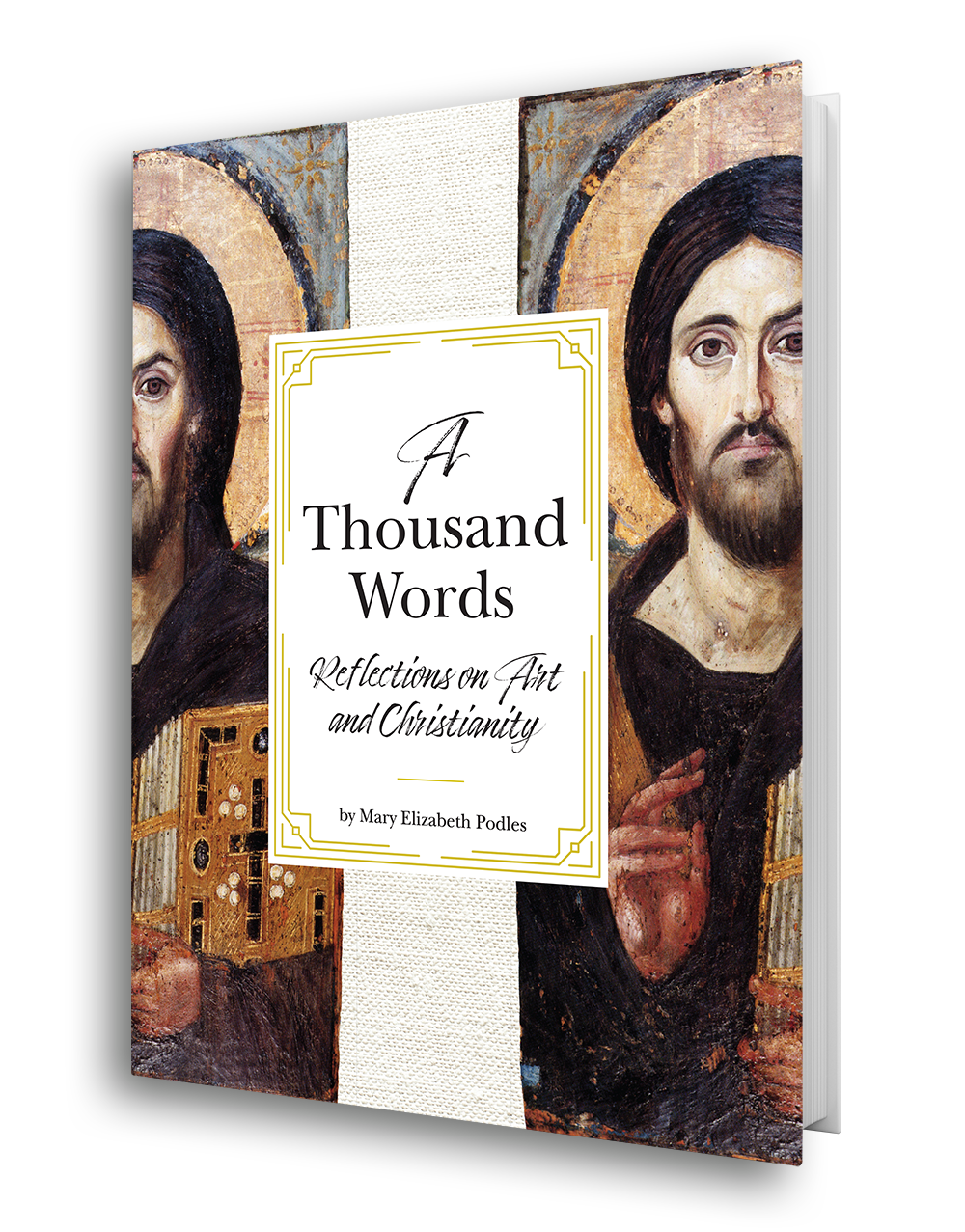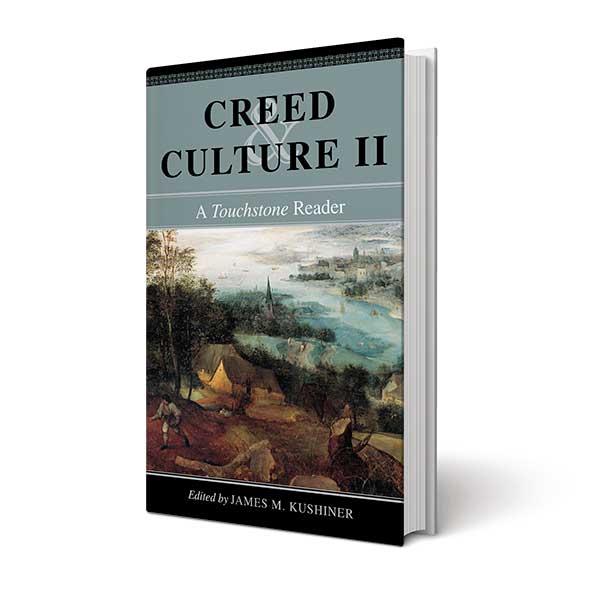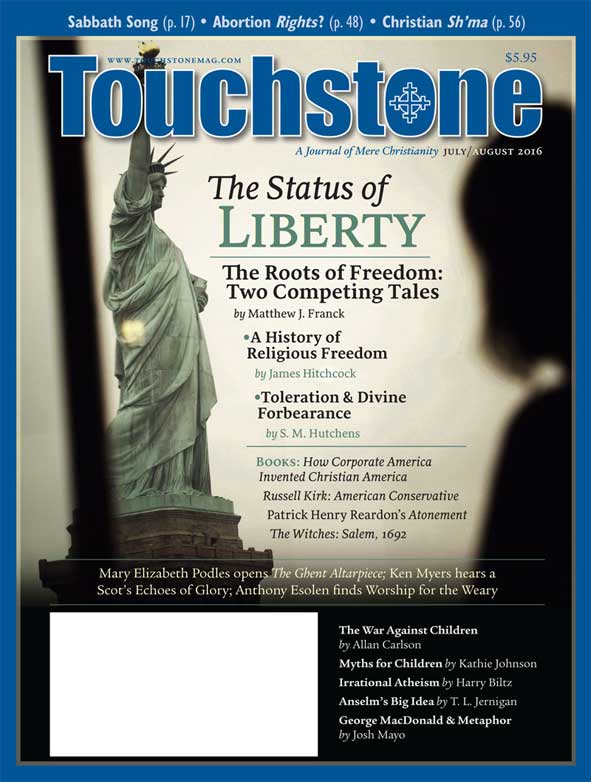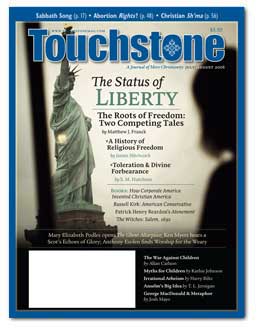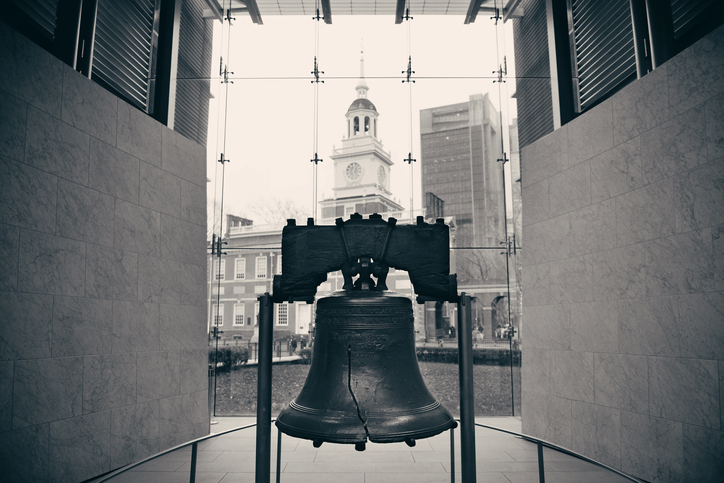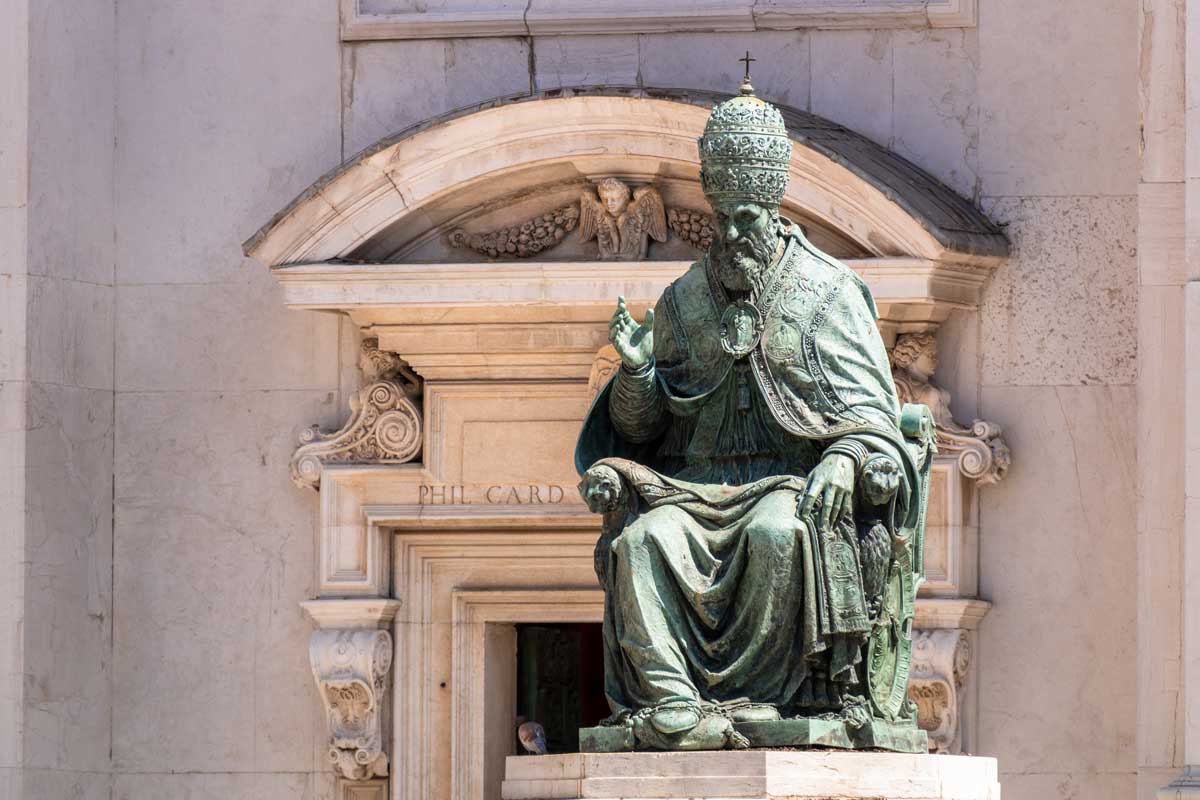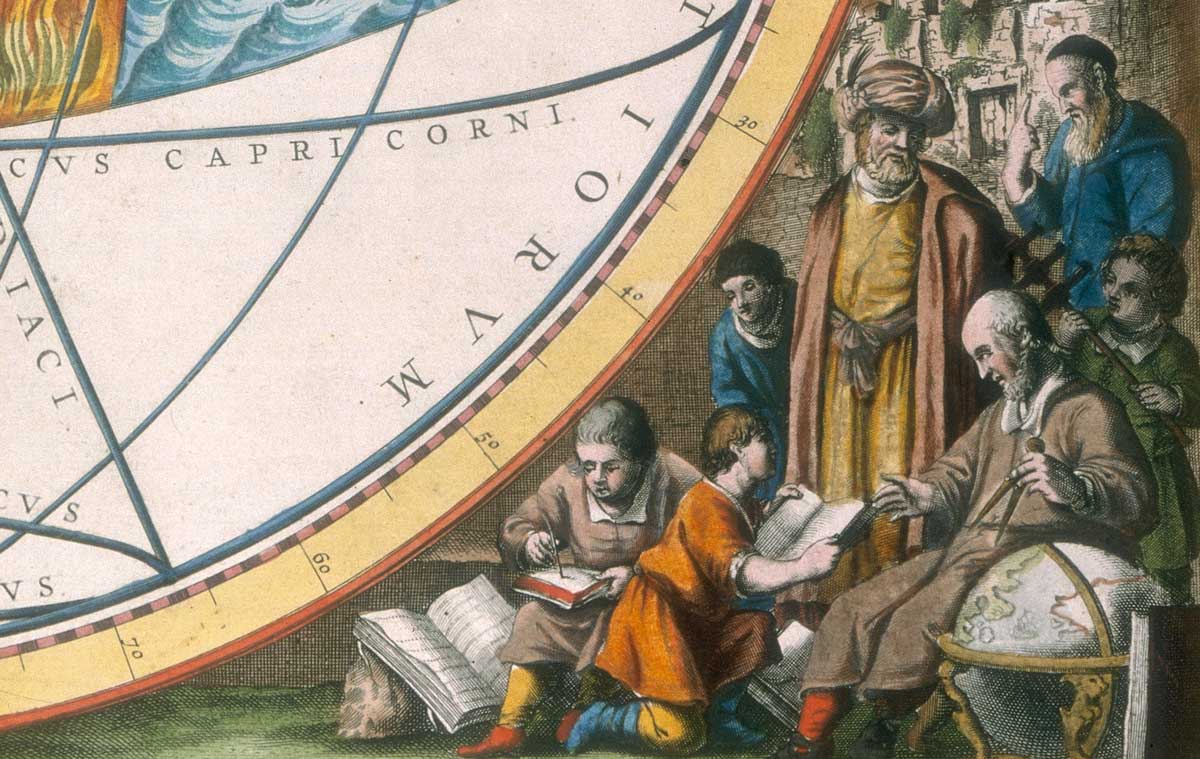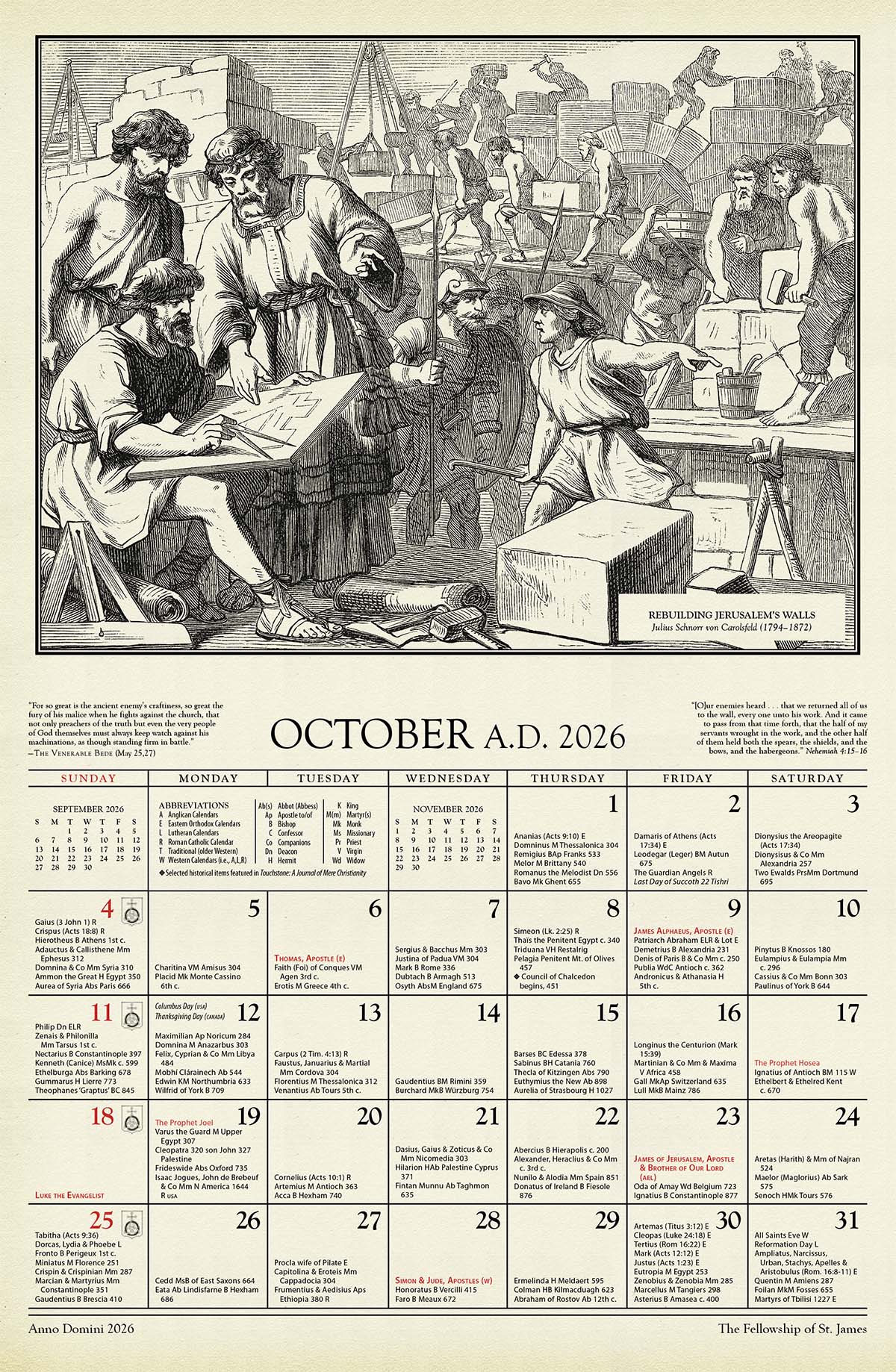Forum: Response
A History of Religious Freedom
Prior to Constantine, coercion in matters of religion was of course unthinkable to Christians, who were themselves the chief victims of such coercion. But leading theologians—Origen, Cyprian, Lactantius—did not offer a merely prudential argument. They affirmed the spiritual nature of a faith that was false if it was not freely chosen.
At the same time, the strongest possible distinction was made between coercion and doctrinal indifference. Already in the New Testament, Christians were told to shun those who denied the faith, and heresy was condemned as the gravest harm to that faith.
Given this distinction, coercion was essentially a political rather than a religious issue—how much did heresy damage the civil order, and what measures were justified to control it?
The first imposition of the death penalty for heresy was on the Spanish bishop Priscillian (385), who was accused by some of his fellow bishops of harboring Gnostic beliefs and being a sorcerer, which under Roman law was a capital offense. But his story is a very tangled one, and civil authorities played a major role in his execution. Ambrose, Martin of Tours, and others condemned the proceedings as a scandalous departure from Christian practice, and some of Priscillian's episcopal accusers were forced to resign
their sees.

Augustine, after agonized meditation, reluctantly accepted coercion in matters of religion because some of the Donatists of North Africa had become a violent sect, armed bands that raided the churches of the orthodox and slaughtered people whom they despised as traitors to the faith. The civil authorities regarded them as criminals who required severe punishment, and Augustine justified such action not because the state had a right to intervene but because the Church had the right to make use of worldly power to achieve its spiritual ends.
Augustine cited the parable of the man who gave a banquet as justification for this coercion, and—momentously—the host's final command to "make them come in" began to echo down the centuries. Augustine speculated that, while coerced faith was not faith at all, the descendants of those coerced might receive true faith. (Augustine's other major opponents—the Pelagians—were not physically coerced but were subjected to spiritual penalties.)
Charlemagne to Bernard
The legitimacy of coercion was accepted only very slowly. Pope Gregory the Great (c. 600) condemned forced conversions. But when Charlemagne (c. 800) brought the Saxons under his control, he ordered them to become Christians, and when he learned that his commands were being disregarded, he slaughtered a reported 4,500 people, despite the objections of his monk-advisor Alcuin of York.
Here again politics was as important as religion. Charlemagne saw the Saxons' acceptance of his religion as a necessary part of their submission to his rule, thereby making their infidelity a form of rebellion. (During the Eucharistic controversies in the century after Charlemagne, only spiritual penalties were imposed on accused heretics.)
Heresy—the denial of the faith once received—was considered a spiritual disease or infection that, if allowed to spread, would poison the entire community. Since God had revealed the truth to his Church, heretics were considered obstinately blind for having departed from that truth, motivated by pride and self-will rather than ignorance. On the other hand, while Jews were frequently subjected to discrimination, harassment, and violence, in church law they were not to be coerced into conversion.
In 1022, twelve canons of Orleans—apparently dualists of a sort who denied the creation of the material world by God—were burned at the stake. After that, there were almost no executions for two centuries. Bernard of Clairvaux (c. 1150), possibly the most influential religious leader of the Middle Ages, denounced the use of the death penalty, and the seminal Fourth Lateran Council (1215) merely imposed banishment.
The Inquisition
But the Inquisition was established in 1184, adhering to the procedures of Roman law whereby an accusation in itself established some presumption of guilt, although the accused were allowed various safeguards. Torture was permitted in order to obtain a confession, but it was used sparingly in heresy cases, since an individual who denied being a heretic was considered to have thereby recanted, which was the Inquisition's chief purpose. Recalcitrants were turned over to a civil government that was commanded by church officials to carry out their execution.
The Inquisition began in France for what were again semi-political reasons—feudal lords in the south defied the king in protecting the dualist movement dubbed Catharism or Albigensianism; it was eventually suppressed by a crusade.
This proved to be the great watershed in the history of religious coercion. Thereafter the systematic prosecution of heresy often culminated in the death penalty.
If the Cathars could be viewed as politically divisive, as were the Lollards in England and the Hussites in Bohemia, the Inquisition also pursued non-political groups like the Waldensians, the Spiritual Franciscans, and an occasional Beguine.
The activities of the Inquisition continually expanded, to include witchcraft and magic. In countries where it was not established, such as France and England, the state itself undertook to prosecute heresy directly. The notorious Spanish Inquisition was unique in that it concerned itself primarily with former Jews and Muslims suspected of having reverted to their original faith.
There was little principled opposition to such coercion. Erasmus of Rotterdam (c. 1500) urged Christians to be forbearing towards one another, but his influence was probably blunted by the suspicion that he was indifferent to doctrinal truth.
Reformation Times
Inevitably, the prosecution of heresy intensified enormously in the Reformation. Thousands of professing Christians were put to death by other Christians, although it was ultimately the state that controlled the process and religious divisions were inseparable from political divisions. (A few Christians followed the almost universally condemned counsel of Nicodemism, which justified denying one's beliefs to escape persecution.)
The Catholic Church advocated coercion, and the leading Magisterial Reformers urged it in certain cases, the principal victims being religious radicals who were viewed as subversive of both religion and civil society, as in their refusal to swear oaths. Dating from the days of the Donatist heresy, rebaptism was a capital crime under Roman law. The brief, terrorist triumph of religious radicals in Münster in the 1530s confirmed the worst fears about "Anabaptists."
Sebastian Castellio was one of the very few Reformation leaders to advocate general toleration, making a case for a kind of doctrinal indifference—centuries of theological controversy showed that some things simply could not be known and certain passages of Scripture were simply opaque. There should be no persecution over non-essential beliefs, although it was precisely such beliefs that motivated most persecution.
Religious groups should be judged by their moral effects, not their doctrines, Castellio urged. Sincerity of conscience did not prove the validity of a belief, but such sincerity was necessary, because "I must be saved by my own faith and not that of another." A mistaken belief might serve as the foundation of a good moral life, although even Castellio thought certain ideas should not be allowed to be preached.
David Joris held similar views, especially emphasizing the wholly inward nature of religion, so that externals should not be a cause of conflict. Rather than persecution, suffering is the mark of the true church. But such arguments worked against their proponents at the time, because they seemed to imply religious indifference.
Both Catholics and Protestants claimed a right of resistance to religious coercion. However, being based on the truth of one's own faith and the falsehood of that of others, that claim did not encompass general toleration.
The Peace of Augsburg
In early modern Europe, toleration was almost always granted for pragmatic secular motives, chiefly the avoidance of religious strife. Absolute rulers also granted toleration because they did not want a church with authority of its own.
In the Peace of Augsburg of 1555 the Holy Roman Empire conceded to each prince the right to determine the religion of his subjects. Those unwilling to accept the religion of their rulers were permitted to emigrate, since it was thought that each territory ought to be religiously homogeneous. Tolerance was granted reluctantly, but it was the first time any European state officially recognized the religious diversity of its subjects.
The Augsburg settlement worked relatively well for over half a century, until a combination of events provoked the Thirty Years' War, the last and greatest of the religious wars, in which policy ruled but religion provided an often murderous passion.
In 1648 the Peace of Westphalia confirmed the princes' right to determine the religion of their subjects. Pope Innocent X condemned the treaty.
Shortly after the Peace of Augsburg, religious wars erupted in France that would last almost forty years. Officially the French crown committed itself to suppressing the French Calvinists (Huguenots), but often events were beyond royal control. Two French kings were assassinated by Catholics for being overly tolerant of Protestants. (The infamous St. Bartholomew's Day massacre of 1574 may have been a ploy by Queen Catherine de Medici and her son Charles IX to embroil Huguenots and ultra-Catholics in a war of mutual extermination.)
Those at the French court who favored religious toleration for the sake of civil peace came to be called the Politiques. Some of them made a strong argument for royal authority, in defense of the king's right to tolerate heresy, and over time Politique thought tended towards royal absolutism as the only guarantor of civil peace.
Jean Bodin, the most important political theorist of the late sixteenth century, was publicly associated with the Politiques. Privately he seems to have doubted the teachings of religion and to have believed that ultimate truth was unknowable.
The Edict of Nantes
In 1598 Henry IV (later assassinated) issued the Edict of Nantes, by which the Huguenot nobility were given complete religious freedom in their own domains, certain cities were designated as places of free worship, and there was to be no discrimination in the universities and the various state bureaucracies. Most remarkably, the Huguenots were permitted to fortify their cities against any attempt to violate the edict, which seemed to envision Catholics and Protestants living side by side in some places.
Subsequently Cardinal Armand de Richelieu (d. 1642), the power behind the French throne, made war on the Huguenots and destroyed their fortresses, because of their semi-independence from royal control. But religious toleration as such remained in effect.
Sixty years later Louis XIV departed from the pragmatism that had hitherto governed royal policy and revoked the edict, an act that sent numerous Huguenots into exile, although many remained—always in danger of persecution—and even occasionally achieved prominence in national life. Louis perhaps acted mainly because religious toleration seemed to show that he did not have full control of his kingdom.
The official Assembly of the Clergy condemned the use of force against the Huguenots, and even Jacques-Benigne Bossuet, the dominant bishop and theologian of the age, doubted its wisdom. Pope Innocent XI congratulated Louis on his action but privately thought it was unwise and ineffective.
Louis's ceaseless drive for territory caused much of Europe to unite against him, especially after he invaded the Rhine Palatinate and oppressed its Calvinist inhabitants. The English, the Netherlanders, and some Germans saw the issue as religious, but at times the anti-French coalition included the Catholic Hapsburgs.
The French Calvinist Pierre Bayle, an exile in Holland, was suspected of being a secret non-believer, since in his great Dictionary he emphasized the innumerable disagreements among religious individuals and groups and the difficulty of knowing certain truth. He was against the revocation of the Edict of Nantes and advocated complete religious toleration, including of Catholics and Muslims, based on liberty of conscience, a position that many of his fellow Huguenots rejected.
But conscience in turn had to be subject to the judgments of reason, and Bayle candidly raised the perplexing question of the authority of conscience to dictate tyrannicide or persecution, concluding that each person had an obligation to follow conscience but that the authorities also had an obligation to punish such actions.
Jesuits versus Jansenists
For over a century, religion and the state in France were locked in a complex relationship because of the Jansenist movement, which was condemned as a kind of quasi-Calvinism in its emphasis on human sinfulness and its seeming denial of free will. At various times Jansenism was condemned by the Sorbonne and by the crown, culminating in a 1713 decree by Pope Clement XI that some French bishops refused to accept.
The Jesuits were Jansenism's greatest antagonists but at the same time were themselves the target of increasing hostility on the part of Catholic monarchs, because they were directly subject to the pope (they were dubbed Ultramontanists because their loyalty was "across the mountains" [the Alps]).
In Scotland, Queen Mary Stuart returned to her native land in 1561, having been widowed by Francis II of France. The Presbyterian movement had firmly established itself during her absence, and a rebellion forced her to flee to England. There was considerable violence between Catholics and Presbyterians in Scotland.
The Netherlands
The Netherlands, under the rule of Spain, had become the most religiously diverse society in Europe, having a majority of Catholics, along with Calvinists, Lutherans, Anabaptists, and Jews, all of whom were tolerated so long as they were economically productive.
Philip II of Spain's efforts to consolidate his rule included a draconian attempt to suppress heresy. The various religious groups in his domain did not respect one another, but all of them, including the Catholics, resented Spanish rule. Resistance to Philip was mounted under William of Orange, a lukewarm Catholic who became a Lutheran and eventually a Calvinist, since the Calvinist burghers of Holland, although only a small minority of the whole population of the Netherlands, were the backbone of the resistance.
Most Catholics probably supported the revolt, but as it succeeded, Calvinists began to see it primarily in religious terms. Mobs attacked Catholics, something that Orange opposed, although for the sake of public order he acquiesced in a temporary ban on Catholicism in some of the northern provinces. He was assassinated by a Catholic in 1584, but by that time the northern provinces had successfully repulsed the Spanish. The southern provinces—roughly modern Belgium—made peace with Spain.
The United (northern) Provinces remained the most religiously tolerant nation in Europe. But it was limited to the right to practice faith in private. Non-Calvinist groups could not have houses of worship and were excluded from public life. Complete tolerance was not even extended to Protestants. In the early seventeenth century the Reformed church was deeply split between orthodox Calvinists and Arminians (named for a theologian), who were accused of smuggling elements of free will and human merit into their account of salvation.
In 1618 the Synod of Dordrecht (Dort) condemned Arminianism. The condemned fought back, and Johan van Oldenbarnevelt, the official "advocate" of Holland, was executed at the instigation of Count Maurice of Nassau, son of William the Silent. The division was as much about princely versus republican power as it was about religion.
The Dutch jurist Johannes Althusius held that the "true church" alone should be recognized in the commonwealth and should be promoted by the authorities, and he apparently assumed that Calvinism was that church. The "true and pure religion" was not to be established "by a majority of the citizens . . . but by the Word of God alone."
Atheists or "libertines" should not be tolerated, according to Althusius. Jews and papists could be tolerated but should be segregated and not allowed to have houses of worship. Heretics should be excluded from public life.
There could be coercion of external actions, even to the point of expulsion from the commonwealth, but not coercion of belief, because religious persecution caused civil disorder. There should be no schism over theological issues that were not fundamental to the faith.
Althusius's commonwealth was theocratic, in that each precept of the Decalogue was political, to be translated into civil law, with the civil magistrates regulating both morals and the enforcement of ecclesiastical decrees.
Another Netherlandish jurist, Hugo Grotius, an exile from his native country after the fall of Oldenbarnevelt, proposed a great reunion of all Christians, which, unusual for the time, he thought included Catholics.
The Portuguese-Netherlandish Jew Baruch Spinoza was expelled from the synagogue as a suspected atheist. He held that there was to be no coercion in matters of religion, but the state was to maintain peace among the various religious groups.
The German jurist Samuel Pufendorf favored a state church, with clergy appointed by the government, but there was to be no coercion of belief.
Poland & Hungary
Along with the United Provinces, Poland was the most tolerant state in Europe in 1600. There was a great deal of anti-Hapsburg feeling, and Lutherans, Calvinists, and others had settled in the kingdom. The monarchy was elective, the nobles had great power, and successive kings showed no desire to persecute heretics. After 1573 each new king had to swear to protect the religious liberties of his subjects, although this extended only to the nobility.
Toleration was also officially limited to Trinitarians. Both a schismatic Calvinist group dubbed the Arians and the followers of the Italian unitarian Faustus Socinus, who settled in Poland, were suppressed in the course of the seventeenth century.
Hungary had a similar history, moving from a religiously diverse, tolerant society after the Reformation to an enforced Catholicism a century later, much of the enforcement being the work of the German emperors.
Elizabeth to Charles I
In Elizabethan England, Catholics occupied a precarious position. Officially outlawed, they were sporadically fined for not adhering to the Church of England. But all priests were viewed as traitors and, if caught, were hanged, often along with the lay people who harbored them.
For Richard Hooker, the principal Anglican apologist, England was a single commonwealth under a divinely appointed ruler, the established church was one embodiment of that commonwealth, and ecclesiastical laws were binding on all subjects.
Far from the adiaphora's being an area of prudential freedom in the church, Hooker held that good order required decisions by the authorities. Those who rejected episcopacy or clerical vestments in the name of Scripture were not exercising legitimate freedom but were merely disobedient subjects.
But while Hooker demanded uniformity of practice and church polity, he favored limited toleration of theological opinion, because some truths were unknowable and controversy was therefore destructive. The church should require adherence only to a basic creed common to all Christians.
Puritan ideas were quite different. The radical Puritans called Separatists, from whom the New England Puritans derived, rejected the royal supremacy and the idea of an established church. A few were put to death as traitors.
The Separatist leader Robert Browne, who eventually returned to the Anglican Church, advocated religious toleration on the grounds that the state had no right to interfere with the church, which was the gathered body of true believers.
James I (d. 1625) took much direct interest in religion, involving himself in 1612 in the last executions for heresy in England, when two anti-Trinitarians were burned at the stake.
The split between the monarchy and the Puritans came to a head under James's son Charles I (d. 1649), particularly because of Archbishop William Laud, who attempted to enforce and even extend practices the Puritans considered popish. Those who attacked him in print were punished by fines, imprisonment, and mutilation.
When, at Laud's urging, the Book of Common Prayer was introduced into Scotland, it provoked rebellion that soon escalated into the Bishops' War north of the border. When Charles called Parliament in order to finance the war, he was confronted with a firestorm of demands, which included the execution of Laud for treason.
The English Civil War
Both sides then took to arms in a civil war, during which Parliament effected the dismemberment of the Anglican Church, while leaving open the question of what should replace it. Parliament won the war, and Charles was beheaded.
A split then developed between Parliament, many of whose members were Presbyterians who wanted an official church, and Independents or Congregationalists, some of whom supported religious toleration.
Oliver Cromwell (d. 1658), the general who successfully pushed for the king's execution, assumed more and more authority, in the semi-monarchical role of Lord Protector, pursuing policies that might be called theocratic.
The uncorking of religious enthusiasm and the abolition of episcopal authority led to an instantaneous proliferation of religious groups. Cromwell tolerated all of them, including Quakers and other radical groups, and he invited the Jews back into England after almost four centuries. Parliament sometimes pushed him to be less tolerant, but he pointed out that England no longer had laws against heresy, and he faulted Parliament for its severe punishment of a Quaker accused of blasphemy.
But Cromwell did not tolerate Anglicanism and Catholicism. During the war, he dealt brutally with Catholics in both England and Ireland, and in Ireland he began the policy of seizing the lands of the Catholic nobility and settling English and Scottish Protestants in their place. Until almost 1800, Irish priests were outlawed and often persecuted by the British government.
John Milton, addressing Parliament during the Civil War, went even further than Castellio in employing arguments that seemed to question the very possibility of religious truth. Good and evil grow up inextricably mixed, so that what might be harmful to one person might be profitable to another. A heretic is one "who believes the truth only because it is told to him." The golden rule was to continue seeking the truth.
The perfection of the church therefore consisted of many different sects and groups, according to Milton, just as a building consisted of many different pieces. God caused the truth "to appear in places we do not expect, and He causes great commotions." But Milton also warned Parliament that it should not tolerate either popery or "open superstition," because both sought to overthrow the state.
The American Puritans, both during and after the Commonwealth period in England, epitomized the classic position that the state must extend freedom to all who professed the true gospel but not to heretics. Quakers, "antinomians," and the followers of Roger Williams who eventually became Baptists were persecuted, although Williams was able to realize his idea of complete freedom of conscience in his new settlement in Rhode Island. (His ideas seem to have had little influence over the American Founders.)
The Restoration & Glorious Revolution
At the Restoration (1660) Charles II proposed a pragmatic policy of limited religious toleration, but the staunchly Anglican Parliament rejected the idea, and Dissenters (non-Anglican Protestants) were barely tolerated.
Officially, Catholics were not tolerated at all, and several were put to death in the fraudulent Popish Plot, a miscarriage of justice that Charles permitted. But he became a Catholic on his deathbed, made a secret agreement with Louis XIV to restore England to the Catholic Church, and successfully fended off attempts to deny the throne to his Catholic brother James.
James II (1685) sincerely desired religious toleration (he was a patron of William Penn) but encountered trouble because he attempted to achieve it by royal edict, without parliamentary agreement, and arrested seven bishops who refused to promulgate his decree. When his wife gave birth to a son, thereby ensuring a Catholic succession, some of the leading men of the kingdom invited his Protestant daughter Mary and her Netherlander husband William to take the throne, and James fled to France.
After this Glorious Revolution, toleration of Dissenters was extended so far as to allow them to have "meeting houses" and to open schools, although they were still excluded from public life and there were numerous restrictions on their conduct. Catholics were still officially outlawed but were usually not prosecuted.
At the same time, the Anglican Church attempted as far as possible to encompass Dissenters. Laud's "high church" policies were abandoned, and an increasingly Latitudinarian theology prevailed—doctrinal indifference as the price of toleration.
In Leviathan, Thomas Hobbes engaged in a lengthy discourse on the authority of Scripture, but in some passages he seemed to offer a wholly naturalistic explanation of religion. True religion ought to be a quiet waiting for Christ's Second Coming, eschewing all theological disputation, endeavoring to lead a good moral life, and obeying the laws of the king, which are also the laws of God.
John Locke, by far the most important theorist of toleration, was the founder of modern Liberalism. But as a highly original thinker his ideas were only gradually absorbed. Anglican Latitudinarianism was Lockean in spirit, but he excluded toleration of Catholics, whom he accused of being politically subversive, and of atheists, because they could not swear trustworthy oaths. A proposal to repeal anti-Catholic laws in 1780 was withdrawn after massive riots. The process of "emancipation" of religious minorities in England took 150 years.
The Enlightenment & Revolutionary Era
On the Continent, the toleration advocated by the Enlightenment often strengthened government control of religion, appealing to rulers who sought to centralize their power, a goal to which the Catholic Church, and especially the papacy, was an at least passive obstacle.
The Holy Roman Emperor Joseph II (d. 1790) especially thought of himself as an enlightened despot and interested himself in religion to the point that he was dubbed "the sacristan emperor." He even decreed the number of candles to be placed on the altar at Mass, a policy of control of the church that came to be called Josephinism.
Joseph closed 700 monasteries, pruned the liturgical calendar (too many holy days interfered with productive labor), redrew diocesan boundaries, forbade the publication of papal bulls, and undertook supervision of the Catholic schools, including seminaries for the education of priests.
Combining Enlightenment ideas with brutal ruthlessness, Portugal during the ministry of the Marquis Sebastiao de Pombal (d. 1782) in a sense foreshadowed the French Revolution. When an attempt was made on the king's life, Pombal blamed the Jesuits and effected their wholesale expulsion or imprisonment. (One was even strangled and burned as a would-be regicide.) In 1773, Pope Clement XIV succumbed to intense pressure and suppressed the order entirely.
The sudden and violent changes of the revolutionary era (1789–1815) permanently altered the intellectual map of the West, with the ideal of "liberty" as its new absolute. Catholics, among others, were resistant to the new Liberalism because of their belief that the social and political orders were based on divine law and could not be altered merely by human will. Many Liberals admitted that their program was necessarily based on a relativistic philosophy that denied the possibility of absolute truth. Catholics also viewed the demand for religious freedom as blatantly hypocritical because, wherever it triumphed, Liberalism tended to curtail the church's rights, often violently.
For a long time, the Vatican paid little attention to the liberal experiment called the United States of America. But eventually the meaning of religious freedom—a question that Christianity faced from its very inception—would be laboriously rethought. •
James Hitchcock is Professor emeritus of History at St. Louis University in St. Louis. He and his late wife Helen have four daughters. His most recent book is the two-volume work, The Supreme Court and Religion in American Life (Princeton University Press, 2004). He is a senior editor of Touchstone.
subscription options
Order
Print/Online Subscription
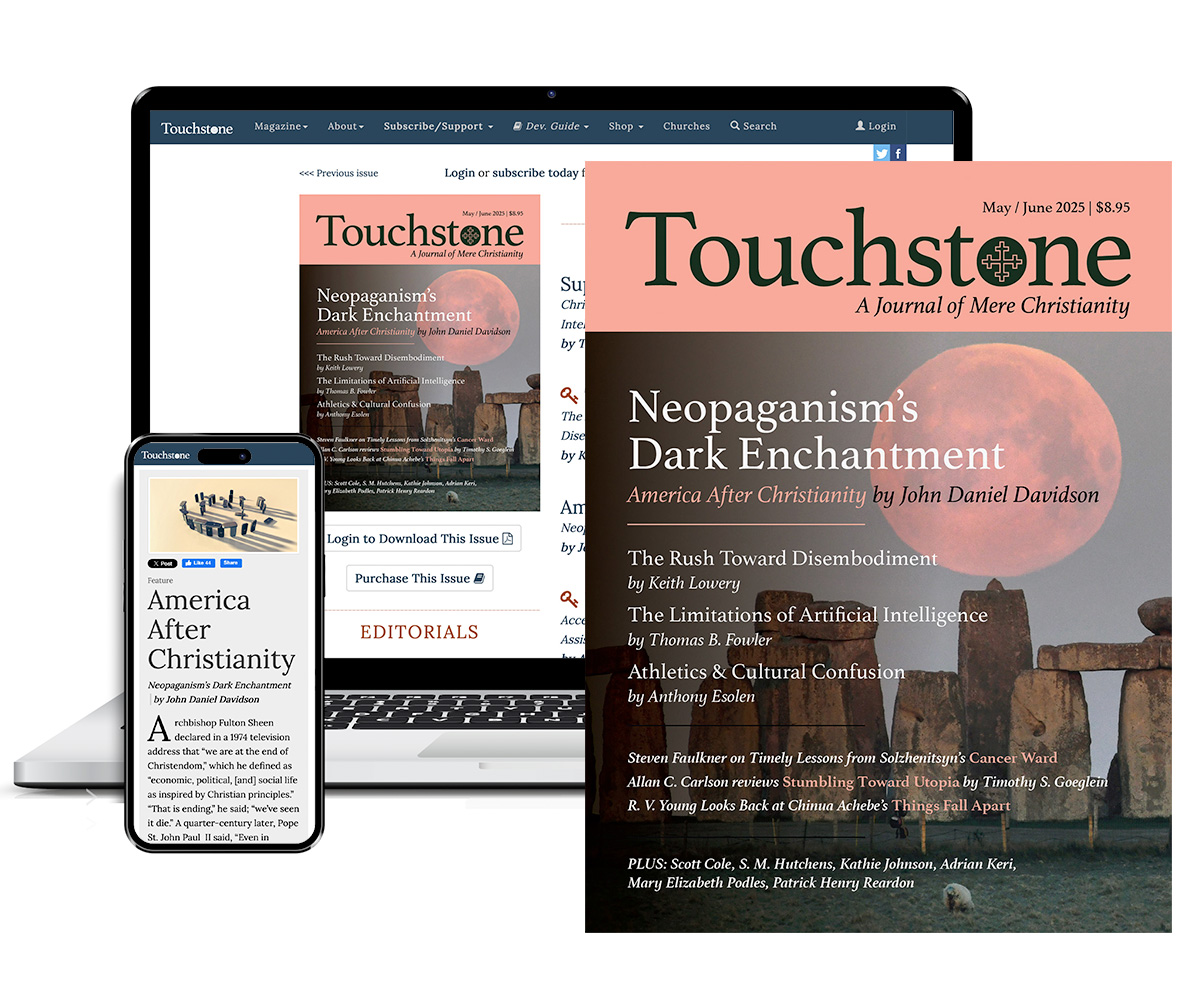
Get six issues (one year) of Touchstone PLUS full online access including pdf downloads for only $39.95. That's only $3.34 per month!
Order
Online Only
Subscription
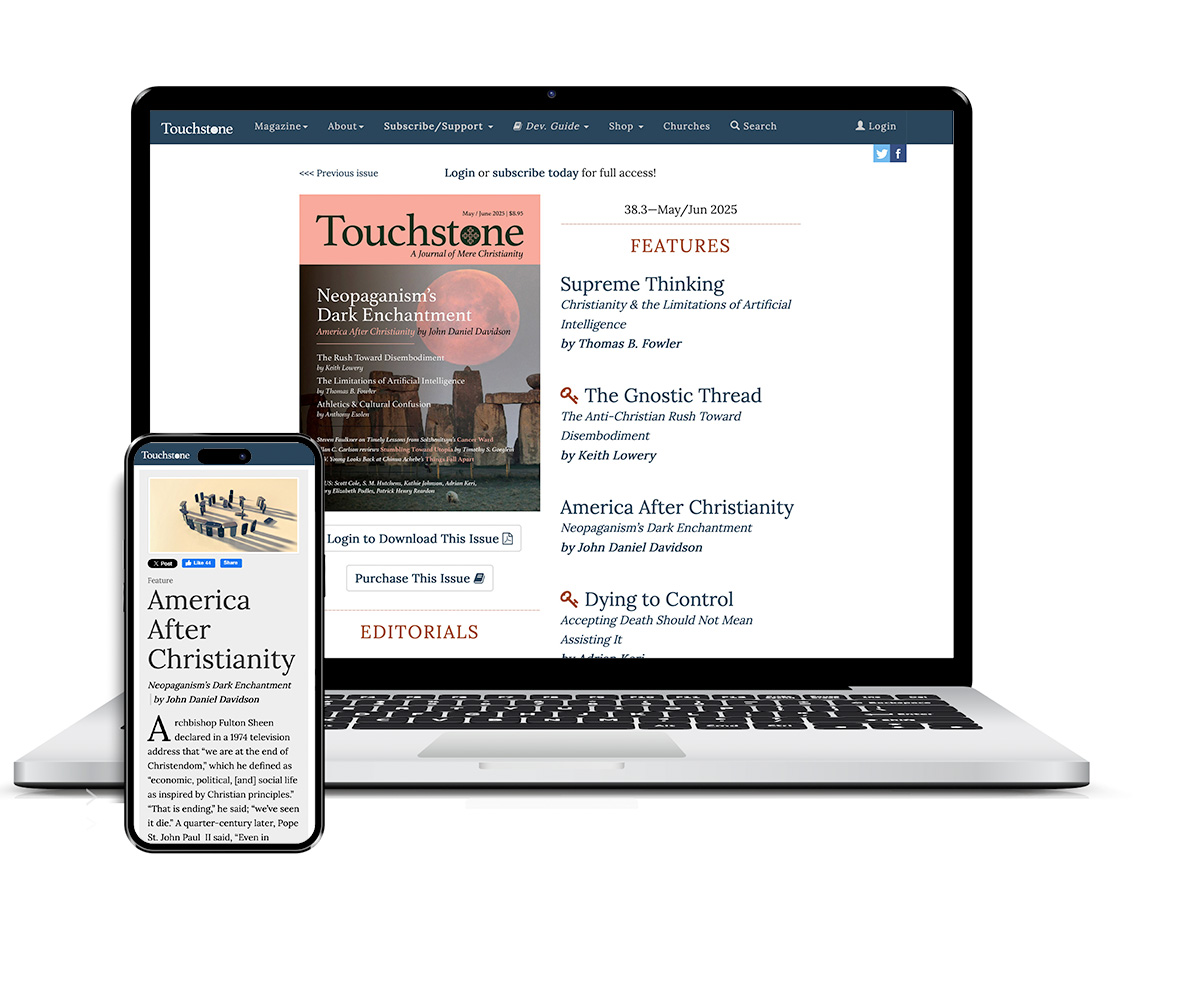
Get a one-year full-access subscription to the Touchstone online archives for only $19.95. That's only $1.66 per month!
bulk subscriptions
Order Touchstone subscriptions in bulk and save $10 per sub! Each subscription includes 6 issues of Touchstone plus full online access to touchstonemag.com—including archives, videos, and pdf downloads of recent issues for only $29.95 each! Great for churches or study groups.
Transactions will be processed on a secure server.
more on Religious Liberty from the online archives
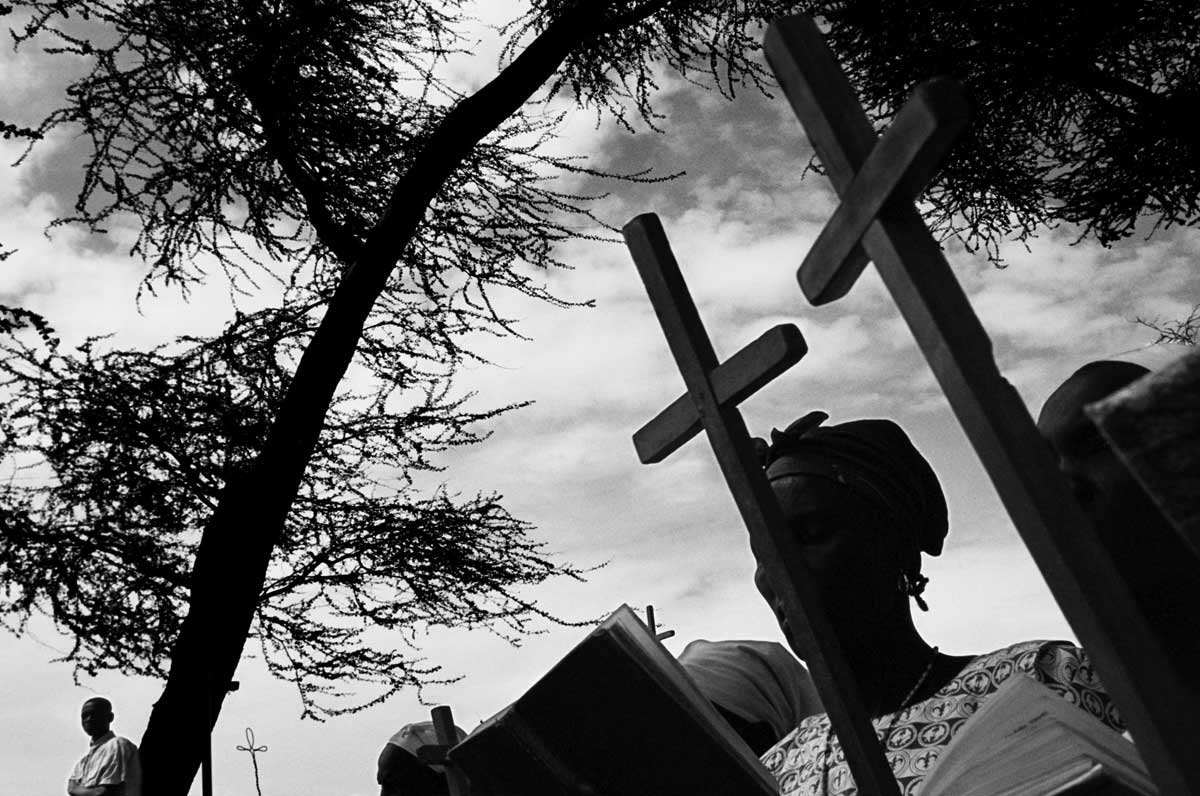
27.3—May/June 2014
Religious Freedom & Why It Matters
Working in the Spirit of John Leland by Robert P. George
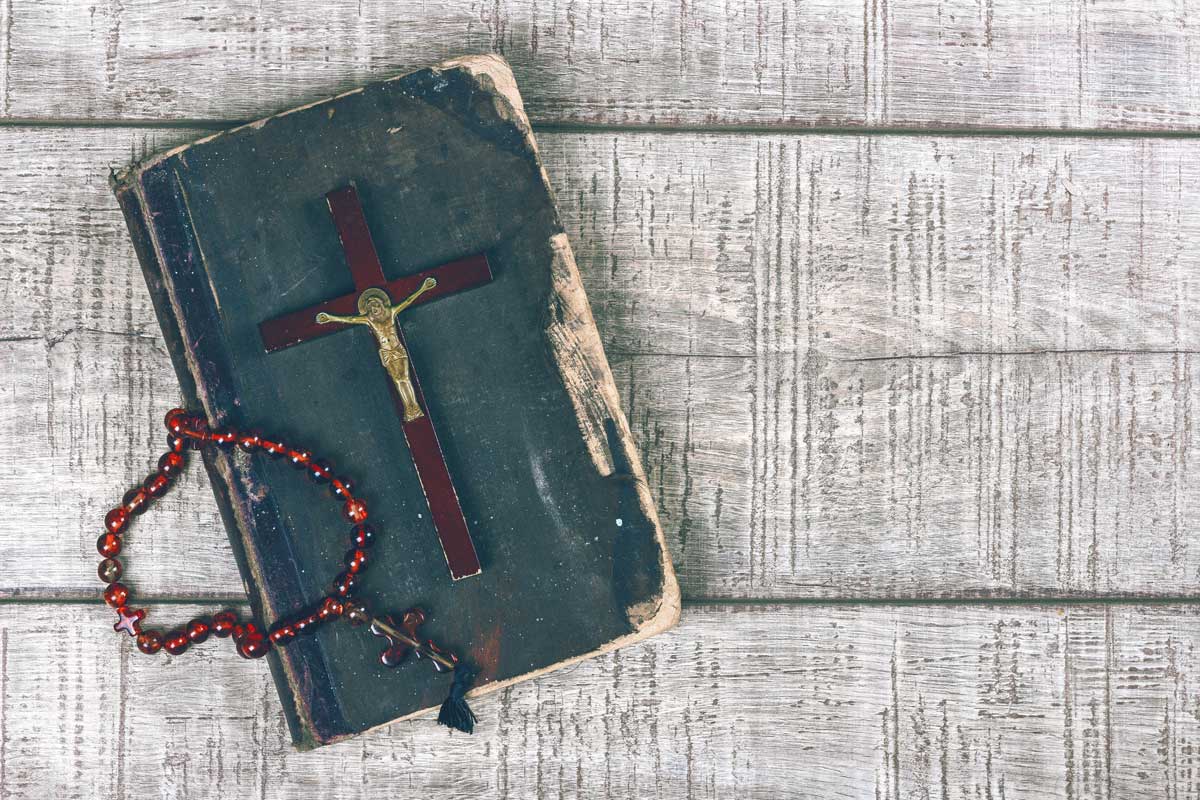
24.6—Nov/Dec 2011
Liberty, Conscience & Autonomy
How the Culture War of the Roaring Twenties Set the Stage for Today’s Catholic & Evangelical Alliance by Barry Hankins
more from the online archives
calling all readers
Please Donate
"There are magazines worth reading but few worth saving . . . Touchstone is just such a magazine."
—Alice von Hildebrand
"Here we do not concede one square millimeter of territory to falsehood, folly, contemporary sentimentality, or fashion. We speak the truth, and let God be our judge. . . . Touchstone is the one committedly Christian conservative journal."
—Anthony Esolen, Touchstone senior editor



